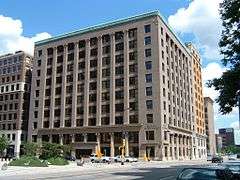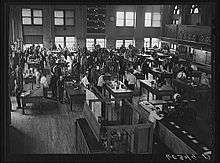Minneapolis Grain Exchange
|
Minneapolis Grain Exchange | |
 | |
| Location | 400 and 412 S. 4th St and 301 4th Ave. S., Minneapolis, Minnesota |
|---|---|
| Coordinates | 44°58′39″N 93°15′49″W / 44.97750°N 93.26361°W |
| Built | 1881 as Chamber of Commerce |
| Architect | Kees and Colburn (main building, 1902), Long, Lamoreaux & Long (east building, 1909), and Bertrand and Chamberlain (north building, 1928) |
| Architectural style | Sullivanesque |
| NRHP Reference # | 95000821[1] |
| Added to NRHP | November 23, 1977 |
The Minneapolis Grain Exchange (MGEX) was formed in 1881 in Minneapolis, Minnesota as a regional cash marketplace to promote fair trade and to prevent trade abuses in wheat, oats and corn.
MGEX has been the principal market for Hard Red Spring Wheat (HRSW) since 1881, offering futures and options contracts based on its unique commodity. HRSW is one of the highest-protein wheats. It is found in bagels, pizzas, high-quality breads and cereals, and some noodles and cookies. It is planted mostly in the U.S. Northern Plains and the Canadian Prairies.
Operations
MGEX offers five financially settled agricultural index products: Hard Red Spring Wheat Index (HRSI), Hard Red Winter Wheat Index (HRWI), Soft Red Winter Wheat Index (SRWI), National Corn Index (NCI) and National Soybean Index (NSI).
In an agreement with Data Transmission Network, (now Telvent DTN), a business-to-business electronic commerce and information services company in Omaha, Nebraska, MGEX has exclusive rights to DTNs agriculture and weather data bases, which the exchange uses to develop index products.
Futures are traded exclusively electronically on the CME Globex platform. Options are traded side-by-side.
Hours of operation
- 6 a.m.: HRSW Futures and Options overnight trading closes and enters pre-open
- 8:30 a.m. - 1:30 p.m.: HRSW Futures trade electronically
- 8:30 a.m. - 1:30 p.m.: HRSW Options trade side by side
- 6 p.m. - 1:45 p.m. Agricultural Index Products trade electronically
- 7 p.m. - 7:45 a.m.: HRSW Futures and Options trade electronically
History

Founded as the Minneapolis Chamber of Commerce in 1881, the MGEX has been a marketplace for producers, processors and millers for more than 125 years. The three Grain Exchange buildings in downtown Minneapolis are now listed on the National Register of Historic Places.
In 1883, the Chamber of Commerce introduced its first futures contract: hard red spring wheat. By 1946 "Chamber of Commerce" had become synonymous with organizations devoted mainly to civic and social issues. In 1947, the exchange was renamed the Minneapolis Grain Exchange. Today the exchange is most recognized by its logo and uses MGEX as first reference.
On December 19, 2008, the Minneapolis Grain Exchange ceased operations of the open outcry trading floor, but continues daily operations for the electronic trading platform. Today, HRSW futures trade exclusively electronically and options trade side-by-side.
See also
Notes
- ↑ National Park Service (2007-01-23). "National Register Information System". National Register of Historic Places. National Park Service.
Further reading
- Kenney, Dave (2006). The Grain Merchants: An Illustrated History of the Minneapolis Grain Exchange. Afton Historical Society Press in collaboration with the Minneapolis Grain Exchange. ISBN 1-890434-74-4.
- Minter, Adam (August 2006). "Gimme Grain!". The Rake. Retrieved 2007-03-28.
- Minneapolis Public Library (2001). "A History of Minneapolis: Milling". Retrieved 2007-03-28.
External links
| Wikimedia Commons has media related to Minneapolis Grain Exchange. |
- Minneapolis Grain Exchange
- Minneapolis Grain Exchange Historical Video
- MGEX Data Warehouse and Globex Audit Trail Parser distribution site.